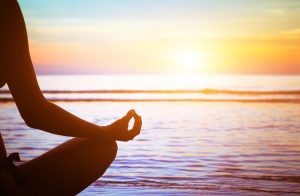
Integrate the mind, body, and spirit through modalities that connect you to the present moment and activate your innate healing capabilities.
 Yoga: Mindful Movement as Medicine
Yoga: Mindful Movement as Medicine
Many of us know the importance of movement and exercise to our health. What is less commonly known is just how deep the practice can go. Movement isn’t simply about trimming our waistlines – it is a cornerstone in maintaining physical and spiritual wellbeing. When we are moving in a healthy way we find our minds are cleared, our bodies are strengthened and our emotions are balanced.
“The practice of yoga induces a primary sense of measure and proportion. Reduced to our own body, our first instrument, we learn to play it, drawing from it maximum resonance and harmony. With unflagging patience we refine and animate every cell… Unlocking and liberating capacities otherwise condemned to frustration and death.”
— “The Illustrated Light on Yoga” by B.K.S Iyengar
Yoga provides the opportunity to move with intention and experience the body, mind, and spirit in a new way. The physical postures, or “asanas”, stretch, strengthen and relax the muscles and organs. The nervous system is toned and refreshed through breath and conscious awareness. Amazing sensations begin to arise in the body as energetic channels are cleared. Emotions are easier to manage as the heart opens. The mind becomes clearer and sharper. You simply feel better—more vibrant and alive. It is from this state that we are best equipped to take on life’s challenges.
“It would bring up things that led me to become aware of myself at a profound level. Before yoga I was always moving too fast and feeling pushed to achieve… Then came yoga, and I was led into a place where breath and movement informed who I became every day. It was not a physical movement that invoked self-judgment and criticism; to the contrary, it was a gentle lover of self. I learned through yoga asana that the body is a map to the soul and that my own body speaks a language that is designed for me to hear and learn from.” — “Teaching Yoga: Essential Foundations and Techniques” by Mark Stephens
At Soltara, we aim to introduce yoga in an accessible yet challenging style. In this way we hope to serve as a stepping-stone to a more robust personal practice and relationship with movement. In the body-mind-spirit practice of yoga, we are becoming more and more aware of how we move, how we breathe, where we are in our minds and how we feel throughout our being. This increased awareness of our own bodies allows for us to take better care of ourselves; affording us the ability to tune into how certain foods, activities and people affect us physically and emotionally.
When we combine the mindful movement of yoga with a healthy lifestyle, we can make incredible strides towards our personal development. Whether we’re enjoying a relaxing massage or experiencing a deep, meditative state through plant medicine, our work with movement allows us to fully absorb every drop of these experiences. When our bodies are relaxed and the need for movement satiated, we are in the optimal state for healing and spiritual development.
Research on the benefits of yoga related to the body and physical health:
An exploratory study1 on the effects of yoga and meditation on cellular aging demonstrated improvement in both cardinal and metabotrophic biomarkers of cellular aging and longevity in an apparently healthy population after a yoga- and meditation-based lifestyle intervention. Making yoga and meditation an integral part of our lifestyle may delay aging, prevent the onset of multifactorial complex lifestyle diseases, promote mental, physical, and reproductive health, and prolong youthful healthy life.
One study2 of 90 people with chronic low-back pain found that participants who practiced Iyengar yoga had significantly less disability, pain, and depression after 6 months.
Research about the benefits of yoga for disease and cancer treatment:
A randomized controlled study3 assessing the impact of yoga practice on quality of life, mood, and perceived stress in women with newly diagnosed breast cancer found improvement in emotional well-being, anxiety, depression, and levels of confusion.
A randomized controlled trial4 on the efficacy of yoga in the treatment of fibromyalgia found the practice highly effective in the management of FM and having a positive impact on physical, psychological and social aspects of FM.
Research regarding yoga and its effects on the mind and mental health:
In a randomized controlled trial5 at a British university, researchers studies the effectiveness of yoga for the improvement of well-being and resilience to stress in the workplace. The yoga group reported marked improvements in feelings of clear-mindedness, composure, elation, energy, and confidence. In addition, the yoga group reported increased life purpose and satisfaction, and feelings of greater self-confidence during stressful situations.
Finally, a study6 on the effects of yoga on the recovery of 100 schizophrenic patients determined that yoga increased their level of functional recovery. It suggested that yoga should be used as a complementary method in nursing practice in order to increase the effectiveness of treatment.
Further research on the benefits of Yoga can be found at: Yoga Alliance
 Meditation: Turning Your Attention to Now
Meditation: Turning Your Attention to Now
When we sit and are present with the mind and the body, we begin to observe that there is space between stimulus and our reaction to it.
Meditation is a tool that allows us to become familiar with the nature of the mind. To know the nature of the mind is to know the nature of fear, of aversion, of attachment, of desire. We also come to know their sources. Arriving in the moment with the intention to sit with whatever may arise is a brave thing to do. We don’t know what we will encounter and when we bravely approach the present, we invite fearlessness into our lives.
There are a lot of assumptions about meditation that can make it unapproachable, but it is not a magical or mystical event. Meditation doesn’t even necessarily have to be spiritual. The goal of meditation is not to control the mind and stop all thoughts, it is to zoom out and create neutral space between the observer and the busy mind. The practice can be as simple as focusing on the breath for a few moments. Though the practice itself may be simple, it can be a real challenge to cultivate a daily practice.
Though the practice of meditation has been refined for thousands of years, science has just begun to scratch the surface of quantifying and measuring the benefits of regular practice.
Studies have suggested that practicing meditation daily offers a wide range of physical, emotional, and mental benefits. Some of these benefits include improved sleep, strengthened willpower, boosted immune system, increased compassion and empathy, improved focus, reduced pain sensitivity, reduced age-related brain atrophy and reduced stress, depression, and anxiety symptoms.
Meditation is an incredible tool and the radical act of sitting with the present is one way that we can actually change the world. This practice that increases compassion, redefines our relationship to pain, and manifests within us as loving kindness toward others is how we will spread peace from the individual to the collective. Avoiding suffering and seeking happiness are natural desires and the tool of meditation teaches us how to attain these states in a sustainable way. As we watch the world around us, it is clear that we are in need of a more altruistic society and meditation is one way to manifest that altruism within.
At Soltara, we aim to provide an environment that deepens your contemplative practices, whatever they may be.
With group meditations scheduled at various times throughout the week, we hope to encourage and facilitate your meditation practice. We highly recommend participating in the morning sunrise meditations on the star deck as the sun peeks up over the mountains to greet us in a new day. Quiet solitude can also be found in our meditation garden which is designed with secluded spaces tucked away for private contemplation.
Conscious Breath
In recent decades, breathwork in its many forms has evolved and become well-known for its therapeutic benefits. Once recognized as an Eastern practice that was comprised of meditation and prana, it is now being used all over the world. Many people claim that the changes experienced through breathwork have included a shift in consciousness, an easier time connecting to self, emotional empowerment, and spiritual integration. The relationship between the breath, state of our health, and even states of mind, has been recognized for centuries in the medical and meditative practices.
So, what is breathwork? Breathwork can be described as “a general term used to describe any type of therapy that utilizes breathing exercises to improve mental, physical, and spiritual health”1. Therapeutic breathwork is the focused purpose of conscious breathing. Some forms of breathwork include: clarity, holotropic, integrative, rebirthing, and Zen yoga, just to name a few. Through alchemy between Eastern practices like yoga and Western psychotherapy techniques such as self-awareness, breathwork has the potential to heal and create lasting transformation in overall health.
In The Healing Power of the Breath, doctors Richard P. Brown and Patricia L. Gerbarg write, “By changing the patterns of breathing, it is possible to restore balance to the stress response systems, calm an agitated mind, and relieve symptoms of anxiety and post-traumatic stress disorder (PTSD),” A few full, relaxed exhales naturally helps to release stress and engage the body’s parasympathetic, “rest and digest,” nervous system. The lymphatic system is also positively affected by breathing. The lymphatic system is responsible in aiding the body’s ability to rid itself of toxins, waste and other unwanted materials. The primary function of the lymphatic system is to transport lymph, a fluid containing infection-fighting white blood cells, throughout the body. The lymphatic system doesn’t have a heart to pump the fluid, so it depends on the body’s movements, one of these movements is breathing.
So, why is this so important?
Lymphatic clogging is a huge factor in inflammation and disease. If the lymph is not flowing well, the cells cannot easily rid themselves of their own waste. Lymph fluid becomes toxic, resulting in fatigue, swelling, infection, inflammation and disease. The benefits of breathing are also represented in its abilities to relax and regenerate cells.
Breathwork as a body-mind therapy creates a conscious connection with the body’s ability to move from restricted chest breathing to an open full body abdominal breathing. Similar to the physical benefits, breathwork therapy can also emotionally purify and integrate subconscious imbalances and release tension by creating higher states of awareness. Breathwork is used to empower you. This is done by your conscious decision to notice your breathing and how it feels in the body, mind and spirit. Some research has shown that a natural byproduct of connected breathing is the stimulation of the longer brainwave patterns (long wave Alpha, Theta and even Delta) normally found during various stages of sleep, transcendent or meditative states of consciousness.
By consciously focusing on the breath and learning different techniques to amplify the therapeutic benefits, we feel this can serve as a valuable tool to help you on your journey. We look forward to sharing these practices with you during our pranayama workshops at Soltara!

 Yoga: Mindful Movement as Medicine
Yoga: Mindful Movement as Medicine


